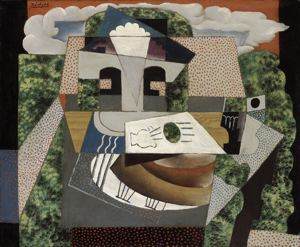
This image is restricted, permission must be requested for reproduction. Downloading for commercial use is prohibited. If you wish to obtain rights to reproduce this image please see our Rights and Reproductions page.
Pablo Picasso
(1881 - 1973)
Still Life in a Landscape
Naturaleza muerta en un paisaje
1915
Oil on canvas
24 1/2 x 29 3/4 in. (62.2 x 75.6 cm)
Century: 20th Century
Credit Line: Meadows Museum, SMU, Dallas. Algur H. Meadows Collection, MM.69.26
Accession Number: MM.69.26
More Information
Visual Description
This painting, which is about 2 feet tall by 2.5 feet wide, is filled with interlocking and overlapping geometric shapes. Picasso defines these shapes with bright shades of red, orange, blue, and green that contrast with cooler shades of white, black, gray, and brown; some of the shapes are filled with compactly arranged orange and blue dots.A landscape of billowy white clouds is displayed on a reddish-orange rectangle near the top of the painting. A patch of blue sky is set within the clouds. In front of the clouds and extending below them, is an arc shape filled with tree foliage in shades of yellow, green, and black. This foliage continues around the perimeter of the painting and is visible as background through openings in the still-life shapes.
Close to the center of the painting is a horizontal shape textured to simulate a plank of wood that seems to serve as a tabletop for still-life elements. On this table is a cluster of purple grapes set in a compote; the grapes are bisected by a white cone that changes some of them into clouds, which extend back up into the tree foliage.
Below the compote, on a gray rectangle, there is a white geometric shape resembling the top of a musical instrument such as a guitar or mandolin; below this are curved brown forms suggesting the instrument’s body. Beneath these forms there are three series of straight and wavy lines that seem to represent a sheet of music. To the right of this grouping is the form of a faceted drinking glass; its rim detached from the body of the glass and set in an adjacent cube. To the lower right is a section of a table leg, extending beyond the bottom edge of the painting. The paint surface in this work is smooth; the brush strokes are visible but not prominent.
Provenance
Norman Granz; (Galerie Berggruen, Paris); (Paul Rosenberg and Co., New York); to Algur H. Meadows, Dallas; donated to Meadows Museum, Southern Methodist University, Dallas, 1969.














